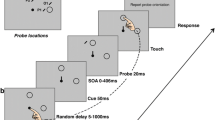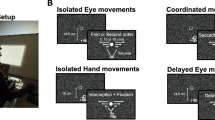Abstract
This study examined two-segment pointing movements with various accuracy constraints to test whether there is segment interdependency in saccadic eye movements that accompany manual actions. The other purpose was to examine how planning of movement accuracy and amplitude for the second pointing influences the timing of gaze shift to the second target at the transition between two segments. Participants performed a rapid two-segment pointing task, in which the first segment had two target sizes, and the second segment had two target sizes and two movement distances. The results showed that duration and peak velocity of the initial pointing were influenced by altered kinematic characteristics of the second pointing due to task manipulations of the second segment, revealing segment interdependency in hand movements. In contrast, saccade duration and velocity did not show such segment interdependency. Thus, unlike hand movements, saccades are planned and organized independently for each segment during sequential manual actions. In terms of the timing of gaze shift to the second target, this was delayed when the initial pointing was made to the smaller first target, indicating that gaze anchoring to the initial target is used to verify the pointing termination. Importantly, the gaze shift was delayed when the second pointing was made to the smaller or farther second target. This suggests that visual information of the hand position at the initial target is important for the planning of movement distance and accuracy of the next pointing. Furthermore, timings of gaze shift and pointing initiation to the second target were highly correlated. Thus, at the transition between two segments, gazes and hand movements are highly coupled in time, which allows the sensorimotor system to process visual and proprioceptive information for the verification of pointing termination and planning of the next pointing.





Similar content being viewed by others
References
Abrams R, Meyer D, Kornblum S (1990) Eye–hand coordination: oculomotor control in rapid aimed limb movements. J Exp Psychol Hum Percept Perform 15:248–267
Adam JJ, Paas FGWC, Eyssen ICJM, Slingerland H, Bekkering H, Drost M (1995) The control of two-element, reciprocal aiming movements: evidence for chunking. Hum Mov Sci 14:1–11
Adam JJ, Buetti S, Kerzel D (2012) Coordinated flexibility: how initial gaze position modulates eye–hand coordination and reaching. J Exp Psychol Hum Percept Perform 38:891–901
Bekkering H, Adam JJ, Kingma H, Huson A, Whiting HTA (1994) Reaction time latencies of eye and hand movements in single- and dual-task conditions. Exp Brain Res 97:471–476
Bekkering H, Adam JJ, van den Aarssen A, Kingma H, Whiting HTA (1995) Interference between saccadic eye and goal-directed hand movements. Exp Brain Res 106:475–484
Bowman MC, Johansson RS, Flanagan JR (2009) Eye–hand coordination in a sequential target contract task. Exp Brain Res 195:273–283
Clark FJ, Horch KW (1986) Kinesthesia. In: Boff KR, Kaufman L, Thomas JP (eds) Handbook of perception and human performance. Sensory processes and perception, vol 1. Wiley, New York, pp 13-1–13-62
Clark FJ, Burgess RC, Chapin JW, Lipscomb WT (1985) Role of intramuscular receptors in the awareness of limb position. J Neurophysiol 54:1529–1540
Collins T, Schicke T, Röder B (2008) Action goal selection and motor planning can be dissociated by tool use. Cognition 109:363–371
Crawford JD, Medendorp WP, Marotta JJ (2004) Spatial transformations for eye–hand coordination. J Neurophysiol 92:10–19
Desmurget M, Rossetti Y, Prablanc C, Stelmach GE, Jeannerod M (1995) Representation of hand position prior to movement and motor variability. Can J Physiol Pharmacol 73:262–272
Epelboim J (1998) Gaze and retinal-image-stability in two kinds of sequential looking tasks. Vis Res 38:3773–3784
Epelboim J, Steinman RM, Kowler E, Pizlo Z, Erkelens CJ, Collewijn H (1997) Gaze-shift dynamics in two kinds of sequential looking tasks. Vis Res 37:2597–2607
Fitts PM (1954) The information capacity of the human motor system in controlling the amplitude of movement. J Exp Psychol 47:381–391
Flanagan JR, Johansson RS (2003) Action plans used in action observation. Nature 424:769–771
Flanagan JR, Bowman MC, Johansson RS (2006) Control strategies in object manipulation tasks. Curr Opin Neurobiol 16:650–659
Gaveau V, Pélisson D, Blangero A, Urquizar C, Prablanc C, Vighetto A, Pisella L (2008) Saccade control and eye–hand coordination in optic ataxia. Neuropsychologia 46:475–486
Gielen CCAM, Van den Heuvel PJM, Van Gisbergen JAM (1984) Coordination of fast eye and arm movements in a tracking task. Exp Brain Res 56:156–161
Hayhoe MM, Shrivastava A, Mruczek R, Pelz JB (2003) Visual memory and motor planning in a natural task. J Vis 3:49–63
Heuer H, Hegele M, Rand MK (2013) Age-related variations in the control of electronic tools. In: Schlick C, Frieling E, Wegge J (eds) Age-differentiated work systems. Springer, Heidelberg, pp 369–390
Johansson RS, Westling G, Bäckström A, Flanagan JR (2001) Eye–hand coordination in object manipulation. J Neurosci 21:6917–6932
Knoblich G, Kircher TTJ (2004) Deceiving oneself about being in control: conscious detection of changes in visuomotor coupling. J Exp Psychol Hum Percept Perform 30:657–666
Lünenburger L, Kutz DF, Hoffmann KP (2000) Influence of arm movements on saccades in humans. Eur J Neurosci 12:4107–4116
Marteniuk RG, MacKenzie CL, Jeannerod M, Athenes S, Dugas C (1987) Constraints on human arm movement trajectories. Can J Psychol 41:365–378
Ma-Wyatt A, Stritzke M, Trommershäuser J (2010) Eye–hand coordination while pointing rapidly under risk. Exp Brain Res 203:131–145
McIntyre J, Stratta F, Lacquaniti F (1998) Short-term memory for reaching to visual targets: psychophysical evidence for body-centered reference frames. J Neurosci 18:8423–8435
Müsseler J, Sutter C (2009) Perceiving one’s own movements when using a tool. Conscious Cogn 18:359–365
Neggers SFW, Bekkering H (2000) Ocular gaze is anchored to the target of an ongoing pointing movement. J Neurophysiol 83:639–651
Paillard J (1982) The contribution of peripheral and central vision to visually guided reaching. In: Ingle D, Goodale M, Mansfield R (eds) Analysis of visual behaviour. MIT Press, Cambridge, pp 367–385
Paillard J, Brouchon M (1968) Active and passive movements in the calibration of position sense. In: Freedman SJ (ed) The neuropsychology of spatially oriented behavior. Dorsey Press, IL, pp 37–55
Paillard J, Brouchon M (1974) A proprioceptive contribution to the spatial encoding of position cues for ballistic movements. Brain Res 71:273–284
Pelz J, Hayhoe M, Loeber R (2001) The coordination of eye, head, and hand movements in a natural task. Exp Brain Res 139:266–277
Prablanc C, Echallier JE, Jeannerod M, Komilis E (1979) Optimal response of eye and hand motor systems in pointing at a visual target. Biol Cybern 35:183–187
Prablanc C, Pelisson D, Goodale MA (1986) Visual control of reaching movements without vision of the limb. Role of retinal feedback of target position in guiding the hand. Exp Brain Res 62:293–302
Pratt J, Shen J, Adam J (2004) The planning and execution of sequential eye movements: saccades do not show the one target advantage. Hum Mov Sci 22:679–688
Rand MK, Heuer H (2013) Implicit and explicit representations of hand position in tool use. PLoS One 8:e68471
Rand MK, Shimansky YP (2013) Two-phase strategy of neural control for planar reaching movements. I. XY coordination variability and its relation to end-point variability. Exp Brain Res 225:55–73
Rand MK, Stelmach GE (2000) Segment interdependency and difficulty in two-stroke sequences. Exp Brain Res 134:228–236
Rand MK, Stelmach GE (2010) Effects of hand termination and accuracy constraint on eye–hand coordination during sequential two-segment movements. Exp Brain Res 207:197–211
Rand MK, Stelmach GE (2011) Adaptation of gaze anchoring through practice in young and older adults. Neurosci Lett 492:47–51
Rand MK, Alberts JL, Stelmach GE, Bloedel JR (1997) The influence of movement segment difficulty on movements with two-stroke sequence. Exp Brain Res 115:137–146
Rand MK, Van Gemmert AWA, Stelmach GE (2002) Segment difficulty in two-stroke movements in patients with Parkinson’s disease. Exp Brain Res 143:383–393
Reed CL, Betz R, Garza JP, Roberts RJ Jr (2010) Grab it! Biased attention in functional hand and tool space. Atten Percept Psychophys 72:236–245
Romero DH, Van Gemmert AW, Adler CH, Bekkering H, Stelmach GE (2003a) Altered aiming movements in Parkinson’s disease patients and elderly adults as a function of delays in movement onset. Exp Brain Res 151:249–261
Romero DH, Van Gemmert AW, Adler CH, Bekkering H, Stelmach GE (2003b) Time delays prior to movement alter the drawing kinematics of elderly adults. Hum Mov Sci 22:207–220
Rosonbaum DA (1991) Human motor control. Academic Press, San Diego
Rossetti Y, Stelmach G, Desmurget M, Prablanc C, Jeannerod M (1994) The effect of viewing the static hand prior to movement onset on pointing kinematics and variability. Exp Brain Res 101:323–330
Sailer U, Flanagan JR, Johansson RS (2005) Eye–hand coordination during learning of a novel visuomotor task. J Neurosci 25:8833–8842
Short MW, Fischman MG, Wang YT (1996) Cinematographical analysis of movement pathway constraints in rapid target-striking tasks. J Mot Behav 28:157–163
Sidaway B, Sekiya H, Fairweather M (1995) Movement variability as a function accuracy demand in programmed serial aiming responses. J Mot Behav 27:67–76
Teasdale N, Bard C, Fleury M, Young D, Proteau L (1993) Determining movement onsets from temporal series. J Mot Behav 25:97–106
Van Donkelaar P (1997) Eye–hand interactions during goal-directed pointing movements. NeuroReport 8:2139–2142
Van Donkelaar P, Lee JH, Drew AS (2000) Transcranial magnetic stimulation disrupts eye–hand interactions in the posterior parietal cortex. J Neurophysiol 84:1677–1680
Vercher JL, Magenes G, Prablanc C, Gauthier GM (1994) Eye–head–hand coordination in pointing at visual targets: spatial and temporal analysis. Exp Brain Res 99:507–523
Vesia M, Crawford JD (2012) Specialization of reach function in human posterior parietal cortex. Exp Brain Res 221:1–18
Vindras P, Desmurget M, Prablanc C, Viviani P (1998) Pointing errors reflect biases in the perception of the initial hand position. J Neurophysiol 79:3290–3294
Vindras P, Desmurget M, Viviani P (2005) Error parsing in visuomotor pointing reveals independent processing of amplitude and direction. J Neurophysiol 94:1212–1224
Weiss P, Stelmach GE, Hefter H (1997) Programming of a movement sequence in Parkinson’s disease. Brain 120:91–102
Acknowledgments
This research was supported by Grant Ra 2183/1-1 of the German Research Foundation (DFG). I thank Maia Iobidze for her support in data collection. The author declares no competing financial interests.
Author information
Authors and Affiliations
Corresponding author
Rights and permissions
About this article
Cite this article
Rand, M.K. Segment interdependency and gaze anchoring during manual two-segment sequences. Exp Brain Res 232, 2753–2765 (2014). https://doi.org/10.1007/s00221-014-3951-8
Received:
Accepted:
Published:
Issue Date:
DOI: https://doi.org/10.1007/s00221-014-3951-8




